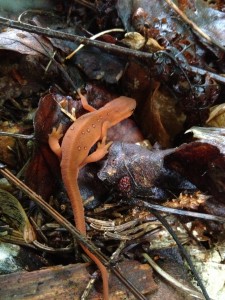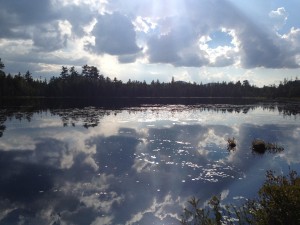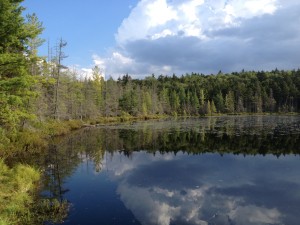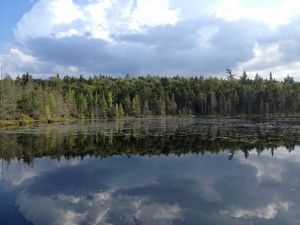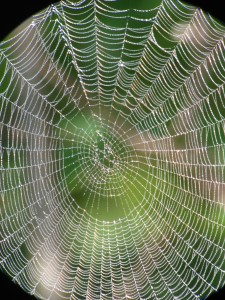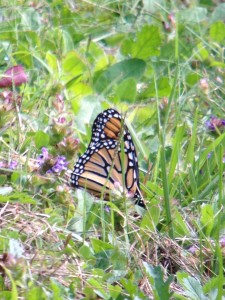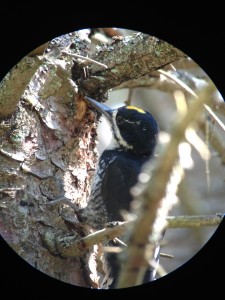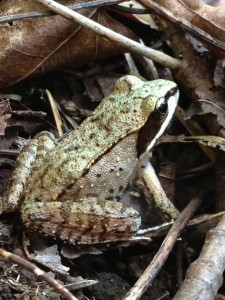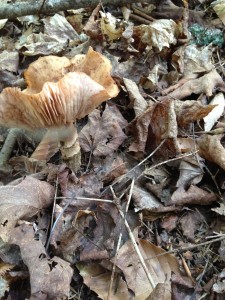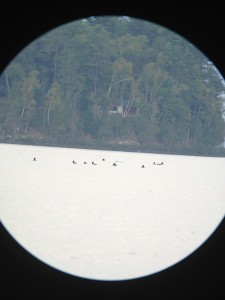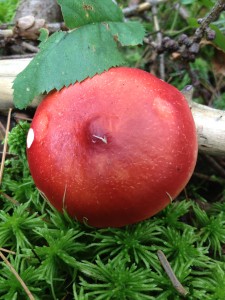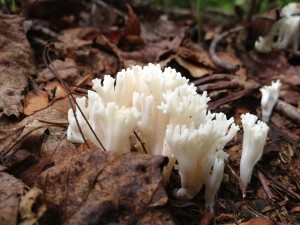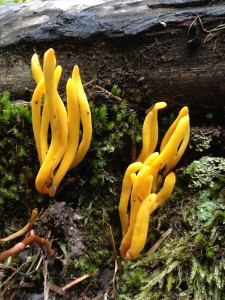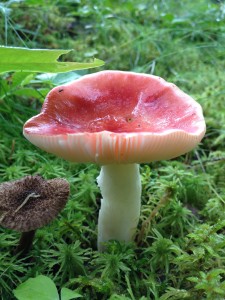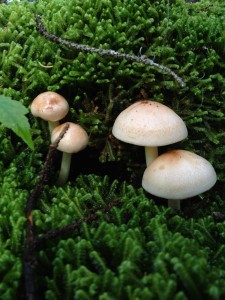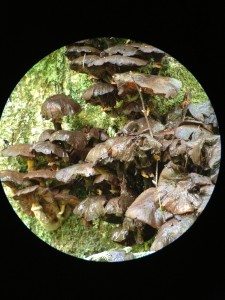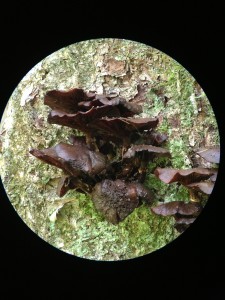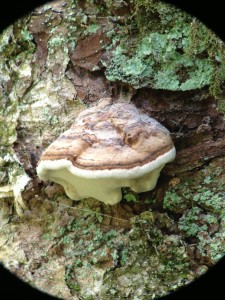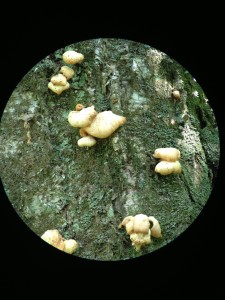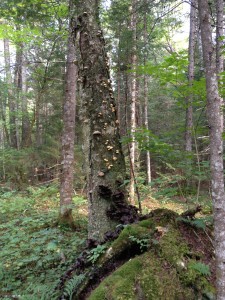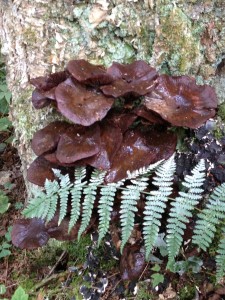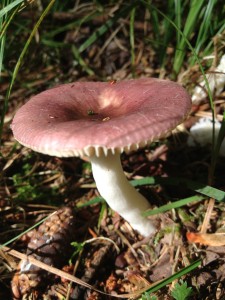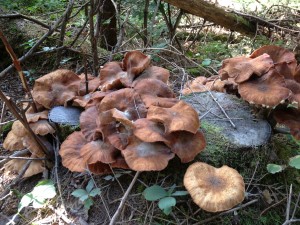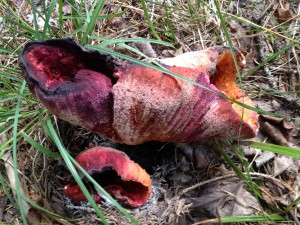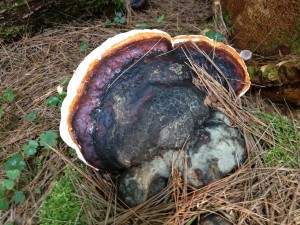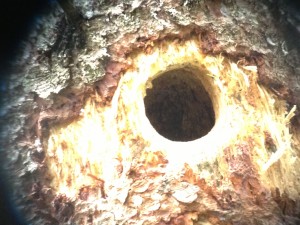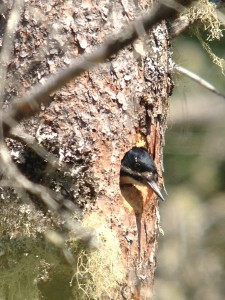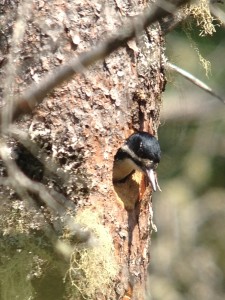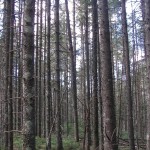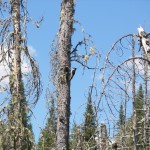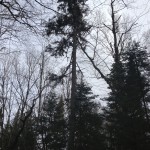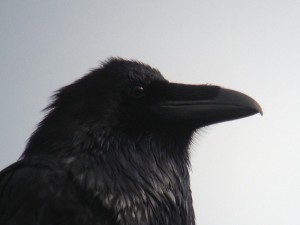 In October 2011, in late afternoon on a clear fall day, a large congregation of Common Ravens was observed along Route 30 in the central Adirondack Town of Long Lake, New York near the intersection with Sabattis Circle Road. Well over one hundred ravens perched up in trees lining the highway in an area that contains both boreal and mixed forest habitats. The ravens were extremely vocal, loudly giving their seemingly endless array of calls. From the vantage point of my car-blind parked at the intersection, and with windows down, observations continued for over two hours.
In October 2011, in late afternoon on a clear fall day, a large congregation of Common Ravens was observed along Route 30 in the central Adirondack Town of Long Lake, New York near the intersection with Sabattis Circle Road. Well over one hundred ravens perched up in trees lining the highway in an area that contains both boreal and mixed forest habitats. The ravens were extremely vocal, loudly giving their seemingly endless array of calls. From the vantage point of my car-blind parked at the intersection, and with windows down, observations continued for over two hours.
The Common Ravens deafening chorus of calls continued. After about ten minutes, Eastern Coyotes began to howl from a long distance away in the forest across the highway from my vehicle. Two ravens, loudly vocalizing, flew in the direction of the coyotes. They flew back and forth between the large gathering of ravens and the direction of the howling coyotes. The howling ceased and the ravens continued to loudly vocalize with the pair of ravens continuing their flights toward the coyotes and then back again toward the other ravens. About a half hour later, crunching leaves were heard as unseen animals paced back and forth just behind the trees up on the bank along the highway directly across from my vehicle. The ravens continued to vocalize. As it began to grow dark, a coyote appeared at the top of the bank and headed down to a fresh road-killed deer in the ditch. All of the ravens instantly ceased vocalizing in perfect unison. They stared down at the coyote heading for the deer and remained perfectly still. The coyote began to rip at the deer with its mouth. After a while, a second, much lighter-colored coyote appeared at the top of the bank and tentatively headed for the deer. It was fearful of the passing vehicles, and would run back into the forest every time one passed by. The other coyote appeared unafraid of the traffic. But during a long lull in passing vehicles, it became apparent that the lighter-colored coyote was dominant and a vicious fight ensued with the darker-colored coyote quickly backing off. Each time a vehicle passed, the lighter-colored coyote would run into the forest and the darker-colored coyote would try to feed while the dominant coyote was gone. The darker coyote would immediately back away from the deer carcass when the lighter coyote came back down the bank. The ravens continued to remain absolutely silent and still on their perches as they stared down at the deer carcass and coyotes. They did not attempt to fly down to the carcass as the coyotes began to rip it open.
As it grew quite dark, groups of ravens began to head to a roost somewhere south of the highway. Just as it appeared they had all flown away, two ravens made a circle over the deer carcass in almost total darkness before flying off. It had now grown too dark to observe the coyotes at the deer carcass, so observations ended when the last two ravens flew to their roost.
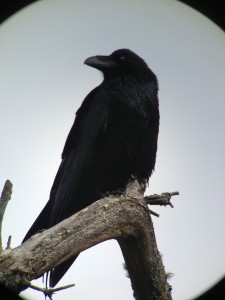 Interpreting animal behavior and communication can often be challenging. Common Ravens need scavengers, like coyotes, to rip open the skin of large mammals before they can feed. If a raven can alert a coyote to potential live prey or carrion, both species benefit. Common Ravens feeding on other predators’ kills is well documented, but ravens leading predators, such as coyotes, wolves, bears, or cougars, to potential live prey or carrion, by using vocalizations, is not as well documented.
Interpreting animal behavior and communication can often be challenging. Common Ravens need scavengers, like coyotes, to rip open the skin of large mammals before they can feed. If a raven can alert a coyote to potential live prey or carrion, both species benefit. Common Ravens feeding on other predators’ kills is well documented, but ravens leading predators, such as coyotes, wolves, bears, or cougars, to potential live prey or carrion, by using vocalizations, is not as well documented.
Bernd Heinrich offers possible evidence in his book Mind of the Raven, which suggests ravens lead predators to potential food. In a couple of the news stories he recounts, humans credited ravens’ vocalizations with saving their lives – one from a cougar and one from a bear. Heinrich has just the opposite interpretation and believes that the ravens were alerting these predators to potential prey, and as a result, both species would benefit with food. It is a much more likely explanation than ravens benevolently vocalizing to save a human from a potential predator!
The October 2011 observations appeared to be Common Ravens leading Eastern Coyotes to carrion through vocalizations. It is a mutually beneficial relationship when predators pay attention to raven (or crow) vocalizations that lead to potential food for both species. Ravens cannot kill large prey nor open the skin of large carrion (such as intact road-killed deer). But they can easily spot potential live prey and carrion from the air. By ravens utilizing vocalizations to communicate, and lead, land-based predators to live prey or carrion that the ravens have observed from above, benefits both species with food. This apparent symbiotic relationship between Common Ravens (along with other corvids such as American Crows) and predators merits further study.
A Couple of Other Brief Related Observations
Over a decade ago, loud American Crow vocalizations were heard outside our home in Long Lake, New York in the central Adirondack Mountains. From the vantage point of our front porch, two American Crows were observed. One was perched over an out-building, and another in a tree across the lawn. Between the crows, an Eastern Coyote was slowly making its way toward the crow over the out-building. At the time, a feral cat had taken up residence in this building. The coyote eventually spotted me and ran off. It appeared that the crows were luring the coyote toward the building with the feral cat. It is difficult to clearly interpret this type of behavior, but there appeared to be communication going on between the American Crows and the Eastern Coyote that morning.
During a decade hiking with two Golden Retrievers, it quickly became apparent that there is an innate relationship among corvids and canines. Common Ravens were encountered on nearly every hike and the ravens appeared to be attracted to the dogs, and the dogs nearly always responded to raven vocalizations by looking up. It was a relationship that could not be missed over the course of a decade!
More images of the Adirondack boreal…
Here is another photographic blog with miscellaneous photographs taken during August 2013, mostly in boreal habitat:
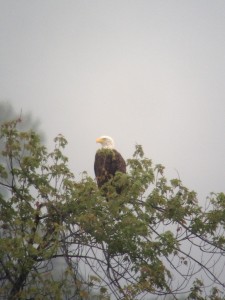
Adult Bald Eagle perched over Tupper Lake just after a non-stop attack on a Great Blue Heron. Taken on August 15, 2013.
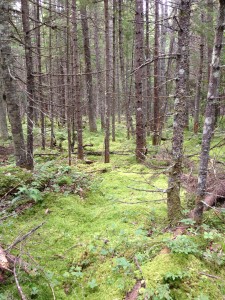
Lovely boreal forest along the Northville-Placid Trail in Long Lake. Photographed on August 18, 2013.
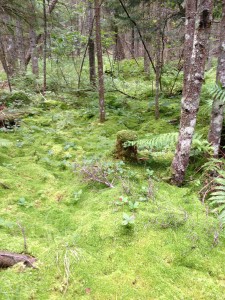
Sphagnum Moss in the boreal forest along the Northville-Placid Trail in Long Lake. Photograph taken on August 18, 2013.
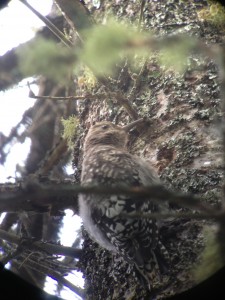
Juvenile Yellow-bellied Sapsucker blending in along the Northville-Placid Trail in Long Lake. Photograph taken on August 18, 2013.
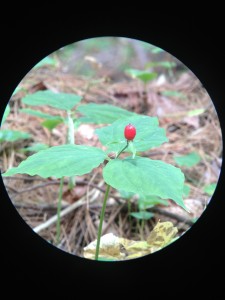
A trillium gone to berry along the Northville-Placid Trail in Long Lake. Photograph taken on August 18, 2013.
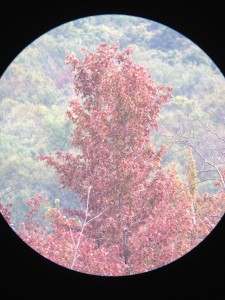
Leaves begin to change color in early August in the Adirondacks. Photograph taken on August 18, 2013 at the north end of Long Lake.
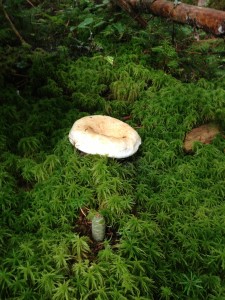
Large mushroom growing in the sphagnum moss along the Northville-Placid Trail in Long Lake. Photograph taken on August 27, 2013.
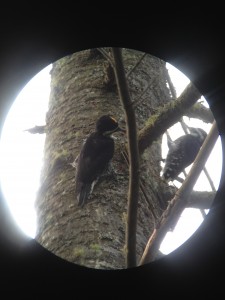
A juvenile male Black-backed Woodpecker (left) begging from an adult male Black-backed Woodpecker (right) along the Northville-Placid Trail in Long Lake. Photograph taken on August 27, 2013.
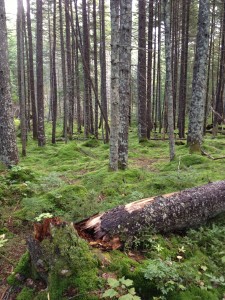
Lovely boreal forest near Helldiver Pond in Moose River Plains. Photograph taken on August 29, 2013.
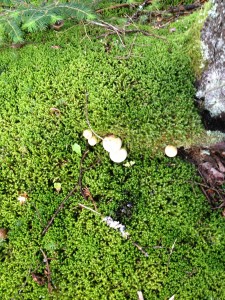
Mushrooms growing from sphagnum moss in the boreal forest near Helldiver Pond in Moose River Plains. Photograph taken on August 29, 2013.
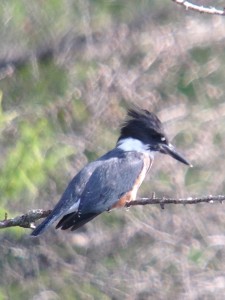
Belted Kingfisher hunting over Helldiver Pond in Moose River Plains. Photograph taken on August 29, 2013 from way across the pond!
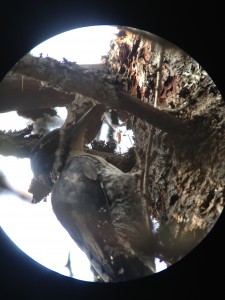
Female Black-backed Woodpecker at Moose River Plains (between Helldiver Pond and Lost Ponds Trails). Photograph taken on August 29, 2013.
August mushrooms of the boreal forest
With a record wet late spring – early summer in the Adirondacks, it is turning out to be an excellent season for mushrooms! I have included photographs taken during August 2013 outings in the boreal forest below:
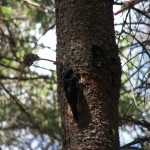
On July 18, 2013, I found an active Black-backed Woodpecker nest site in Minerva (western Essex Co., NY). The male and female were feeding the young inside the nest hole. This indicates the nest is six to seven weeks later than normal for our area.
I initially found this nest hole on May 4, 2013 when the male Black-backed Woodpecker was excavating the cavity. The hole is in a live, mature Tamarack tree approximately 25 feet off the ground. The male finished excavation of the nest hole, but I never found any subsequent evidence of nesting. I visited the location multiple times and spent several hours at the location on June 10, 2013, when I should have observed active feeding of young, as I was observing at other Black-backed Woodpecker nest sites in the Adirondacks. There was no activity near the nest hole that day, and I found a male Black-backed Woodpecker a good distance away. At the time, I wondered if something had happened to the female Black-backed Woodpecker. On other visits in May and early June, I observed the male Black-backed Woodpecker in the general area, but saw no sign of a female or any activity near the nest hole.
As I was hiking the trail in Minerva on July 18, 2013 around noon, a female Black-backed Woodpecker began to call non-stop and the male gave a rattle-call. As I observed the female calling, I also heard the chirring sound of Black-backed Woodpecker young coming from a nest hole. I was surprised to find that the nest hole was indeed used (after all that work on the part of the male in early May!). I made a huge circle around the nesting area so I would not be anywhere near the nest hole. I sat on the mossy ground and just observed the hole from a distance. The female continued to call for a few minutes, but never took the defensive position in the nest cavity. She flew off to forage after a couple minutes. As she came back with food, the male flew in and gave one rattle call as he went into the nest hole with food. After he left, she flew in to feed the young. Black-backed Woodpeckers feed the young inside the nest cavity during their first two weeks of life before the young are old enough to be fed at the hole. The young are typically 24 days old when they fledge. It is likely that the young at this nest will not fledge until the beginning of August! I typically see Black-backed Woodpeckers fledge just after the 3rd week of June. I have already observed family groups of Black-backed Woodpeckers moving around in other locations.
The Birds of North America account for Black-backed Woodpecker states that, “If eggs pilfered, female will lay a second set, often in same nest (Bent 1939).” This may indeed be the case for this nest site, but I never saw evidence of nesting after the male finished the excavation. I will never know exactly what happened earlier in the season. It was certainly quite a surprise to find such a late Black-backed Woodpecker nest today! I will continue to observe them over the next couple weeks.
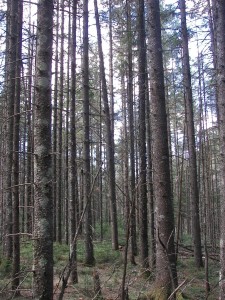
- Male Black-backed Woodpecker excavating a nest hole in a live, mature Tamarack tree about 25 feet off the ground on May 4, 2013.
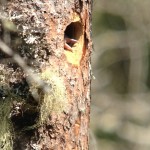
In early May, I found a couple different Black-backed Woodpecker nest sites. The male does all the excavation of the nest hole, which can be in a live tree, dead snag, or even a telephone pole! I have observed nests that ranged from 15 feet above the ground to 65 feet above the ground. One particular nest location this year was in a dead snag about 15 feet above ground. I frequently observed this nest site with clients over the past couple months. It was discovered by many local birders and people frequented the location daily, including folks out walking their dogs.
The male not only does all of the excavation, but he does all of the nighttime incubation and almost all of the fecal sac removal to keep the nest hole clean once the young are born. It was lovely to see how hard both parents worked to constantly feed the very loud nestlings! Black-backed Woodpecker young vocalize non-stop with a constant churring noise coming from the nest hole. You wonder how they survive when they make so much noise. The vocalizations became louder as adults flew in with food – so we would spend time talking and as the young became louder, it would alert us to another feeding session. When the young are big enough, the parents feed them by leaning in the hole. I ended up with lots of photographs of the baby heads sticking out seeking food. I observed two heads, and one client saw three heads at the hole. (They typically have 3 to 4 young.)
I observed a couple of interesting behaviors to note. The parents would sometimes give a softer version of their “kyik” call note and the young would immediately fall silent in the nest hole. It was apparent that it was a signal to be quiet. Also, several times the female Black-backed Woodpecker entered the hole and stuck her head out – sometimes with the bill sticking straight out and sometimes with her head and bill pointed down. This behavior would usually last about 15 to 20 minutes and the young would be completely silent during this period. It appeared to me that she feared a predator and was in a defensive position. Larry Master also noted this behavior when he visited the nest site, and said that he, too, noticed it was the female that was in a defensive position. Larry said that a couple of Common Grackles tried to predate the nest and that the Black-backed Woodpecker adults chased them off. Sean O’Brien once observed a Black-backed Woodpecker in this defensive position inside a nest hole that nailed the face of a Red Squirrel attempting to predate a nest in the same area.
On June 23, 2013, I was with a couple clients and we hiked to the Black-backed Woodpecker nest site. I was a bit concerned as we approached the nest and I did not hear the churring of the young. I set up my scope to view the nest hole, which is out in a swamp area, and I looked into the scope and viewed a Red Squirrel face looking out of the nest hole. I felt sick at the sight. After nearly two months of non-stop work by both parents, they were frantic. The male drummed non-stop on a dead snag next to the nest hole tree, and the female kept flying in to try and peck the squirrel, but she kept flying up as the squirrel would lunge at her. They called – both their short calls and the rattle call. It was an awful scene. We tried different things to get the squirrel to come out of the hole, but it was futile. My clients said they couldn’t stand to watch it any longer so we left. There were no sounds of the young. The young would have fledged in just a few days and they would have continued to be fed by the adults outside the nest. Young in a nest are so helpless, and it was so disturbing to see such a tragic end for these woodpecker babies. Some of the photographs I took over two months are below.
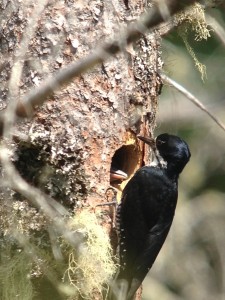
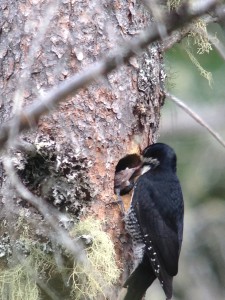
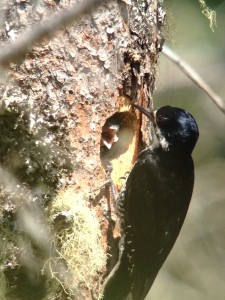
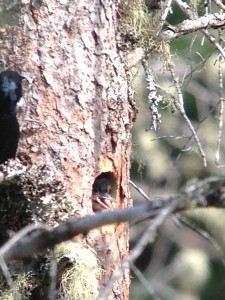
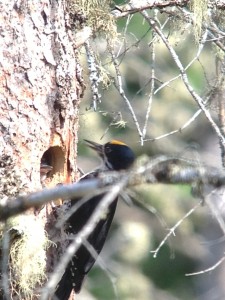
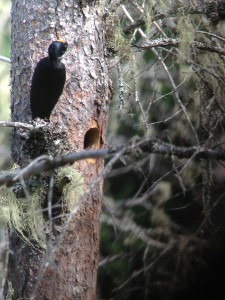
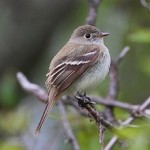
The Least Flycatcher has an unusual behavior among passerines. It forms “aggregations” or “clusters”. In the spring, males establish small territories among a dense cluster of Least Flycatchers, which is reminiscent of a lek mating system.
Least Flycatchers breed in deciduous, and mixed coniferous and deciduous, forests. The largest aggregations of Least Flycatchers that I have observed occur at forest openings. There is a large aggregation outside our house where there are several open acres surrounded by mixed forest, and on the way into Massawepie Mire where there is also a large, circular opening in the forest. Males give their loud “chebec” song all around the forest opening. They have a softer, almost “grumbled”, or also referred to as “guttural”, “speetz” call they give when changing perch locations.
Why do Least Flycatchers form aggregations when most other passerines do not nest in such social groups and establish their own, larger territories? There are several theories, some of which include: female preference for clustered males and pursuit of extra-pair matings, clustering may reduce nest predation, and one that I find intriguing, the open areas near forest aggregations may be neutral feeding grounds used by all the members of the cluster, which reduces conflict and allows for decreased territory sizes.
Least Flycatchers are often described as “pugnacious” and aggressive toward other species. They continuously attack other species when their territories overlap. This aggressive behavior in a cluster of birds may certainly support the theory of reduced nest predation among birds in aggregations.
Further study is needed to fully explain why Least Flycatchers nest in social clusters.
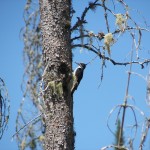
May is a fascinating month to be birding in the Adirondacks! The excavators are busy hollowing out tree space to raise young. In the past week, I have found two Black-backed Woodpecker nest sites, a Red-breasted Nuthatch nest, a Black-capped Chickadee nest, two likely Boreal Chickadee nest locations, and countless Yellow-bellied Sapsucker nests! The Jeopardy category would be titled “species that excavate nest holes”. Early to mid May is the best time to hear the sounds of the excavating activity.
Black-backed Woodpecker males do all the work of excavating a nest cavity. A male will change locations with the female long enough for her to inspect the nest hole before the male continues his non-stop work. Once the work takes him entirely inside the cavity, he occasionally sticks his head out to shake away the wood shavings.
The diversity of Black-backed Woodpecker nest site locations is remarkable. Last year, a pair nested 55 to 60 above the ground in a live Red Spruce tree on a hill. Two other nest hole locations observed that year were about 15 to 20 feet up in dead snags. These two other locations shared a commonality of a wet area filled with dead trees. Another birder observed a Black-backed Woodpecker nest hole in a telephone pole! This year, the first nest found is in a location with mature spruce trees on a hill. The nest is in a tall dead tree among live spruces. The hole is about 25 to 30 feet off the ground. The second nest found is in a wet area of dead snags. The nest hole is about 15 feet off the ground.
Late yesterday afternoon, on May 9, 2013, I ventured out at 4 p.m. to check the area where I had found the nest in a live Red Spruce last year. I immediately heard a Black-backed Woodpecker calling, and found a foraging female. I spent the next 3 hours sitting on the forest floor observing a pair that intermittently foraged and mated three times! They were continuously calling to each other as they foraged and then, as their vocal activity increased, I knew I would see mating again. The Black-backed Woodpeckers increase the frequency of their short calls and then start giving the longer rattle calls as the male flies in to mate with the female on a branch (usually close to the trunk). The male has a very distinctive flight as he approaches the female to mate – a slower, more fluttering, stiff flight pattern. After mating, the male flies away and the female remains on the branch for a short time before going back to foraging. Male Black-backed Woodpeckers actively mate with females during the course of excavating a nest hole. As I was noting the date, it suddenly occurred to me that it was the same date that I observed mating at this location last year – and it was likely the same pair! I have yet to find their new nest location.
On May 7, 2013, I heard a Boreal Chickadee calling at me, so I bushwhacked to the source of the sound. As I always do, I sat down on the mossy ground and tried to be inconspicuous (as much as a human can be…). The Boreal Chickadee continued to vocalize and I wondered if I would discover a nest hole. After awhile, a second Boreal Chickadee arrived and immediately began to inspect the dead trees around me. It continued to make its way closer and closer to me. I remained like a statue. I could hear it behind me a few feet, when suddenly I felt it attempt to land on me! I could feel the swoosh of the wings fluttering over my head. As much as I tried to stay still, it made me flinch, and the bird flew in front of me into a bush about two feet from my face! I have always found Boreal Chickadees to be extremely curious birds, but having one almost land on me was a first!
- Nest hole 25 to 30 feet off ground in dead conifer among live spruces.
- Closer view of the excavating male.
- Nest hole 15 feet off the ground in a dead snag.
- Live Red Spruce where a Black-backed Woodpecker excavated a nest hole 55 to 60 feet off the ground.
